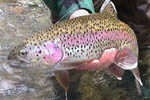It's
August, and my wife and I are in Belize enjoying a few weeks
at our lodge. She’s spending the day diving while I poke
around the mangrove swamps looking for tarpon with "Pops"
Cabral (one of our most experienced guides and namesake of
the "Pops’ Bonefish Bitters" bonefish fly). Taking turns
fishing, Pops and I have caught two tarpon and a mess of
mutton and mangrove snapper for the table, all with my
favorite salt water fly – a white Seaducer with collar of red hackle, tied weighted and weedless.
However, we’ve just found about 20 tarpon crashing a school of bait
fish in 36 inches of crystal clear water, and the fly is about to
get yet another workout.
The tarpon are berserk and
mindless of us and our skiff. They’re feeding all around us. It's
Pops' turn so I jump up on the poling platform and he takes the 10
weight rod to the bow. The fish are everywhere. A long cast isn’t
needed so Pops simply splats the white Seaducer on the water 15 feet
away. A tarpon immediately heads for the fly, opens its mouth wide
enough to put your head in, and sucks in the fly and a bucketful of
water. Pops tightens the line, gives it a pull to set the hook, and
the Tarpon Tango is underway!
The choreography is simple: When
airborne – give slack and bow to the fish. When under water – pull
the line tight and make the fish work hard. The rhythm of give
line/take line/give line/take line continues for several minutes.
The tarpon jumps repeatedly, shaking its head and rattling its gill
plates. The sight of silver dollar sized scales sparkling in the
sunlight as they sail through the air is something no tarpon angler
forgets. However, on its next jump, the tarpon throws the fly and
Pops’ line goes slack. The first dance is over.
But the fish are still berserk,
feeding heavily around the boat. Pops quickly retrieves line to make
another cast, but the fish won’t wait. He barely retrieves three
feet when another tarpon takes the fly. Tarpon Tango Two!! Give
line/take line. But this fish also evades a solid hook set and
throws the fly after several minutes and several spectacular jumps.
Pops once again retrieves a few feet, and a third fish picks up
where the second left off. The tango continues. The dance repeats
with a fourth partner after another few minutes and half a dozen
more jumps. And then a fifth. The rhythm keeps repeating itself.
Give line/take line, spit out the hook, pick up a new dance partner,
and give line/take line all over again.
About 20 minutes later, Pops has
not yet made a second cast, but has just begun the Tarpon Tango with
his sixth partner. The fish are still crashing bait all around us.
The sixth tarpon is solidly hooked and we can see the white Seaducer
firmly imbedded in the corner of its mouth. This dance partner will
not throw the fly. When Pops’ partner begins to tire, it makes a
long run under the boat and, in an instant, all the fish except this
one are gone. No tarpon. No bait fish. Faster than you can blink.
Just Pops and tango partner six, and me standing on the poling tower
laughing my ass off. After I release his fish, I simply lay down on
the deck, smiling at the sun as we let the adrenaline drain away.
I love this fly primarily because
I can see it under the surface and therefore I can usually see the
fish take the fly. Tied about 1˝ inches long on a size 2 hook, its
perfect for large or small mouth bass. About 3 inches long on a 1/0
hook it’s a killer on salt water fish like tarpon, dorado, bluefish,
striped bass, or small tuna. My Belize fly box usually holds about
20 flies for this type of fishing. About 15 are white Seducers and
the other 5 are a mix of other patterns. I always start
fishing with a white Seaducer and I hardly ever use anything else.
With a 4/0 version and an appropriately heavy rod, I’ve hooked
billfish and larger tuna.
How many fly patterns have hooked
up six fish on one cast? This is a fantastic fly.
--Richard
Frailey



